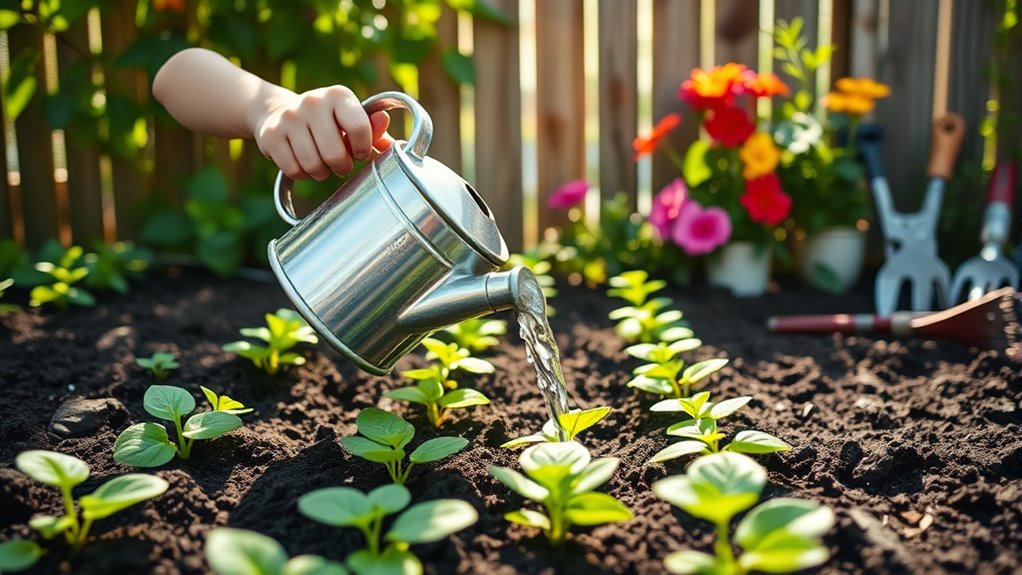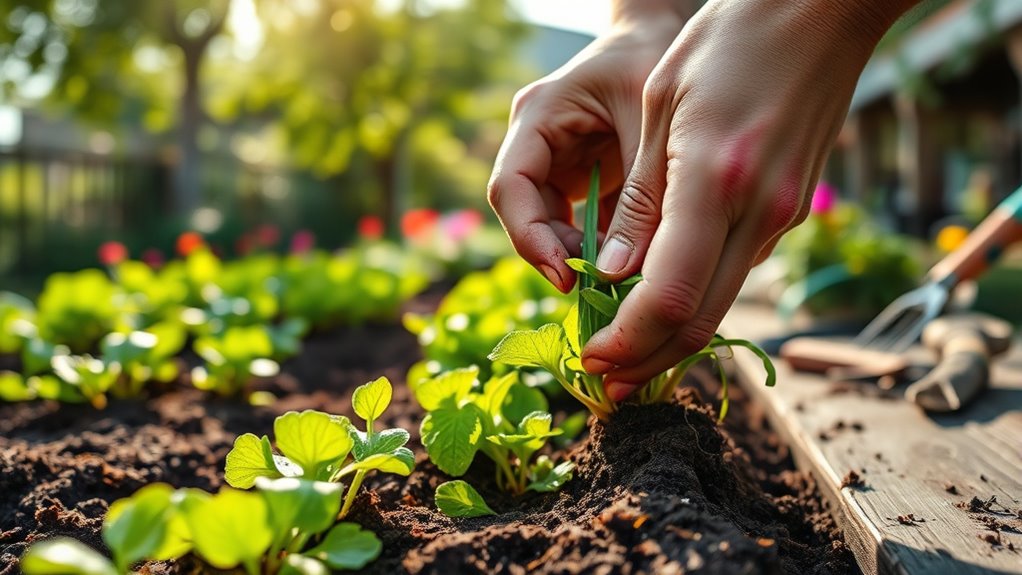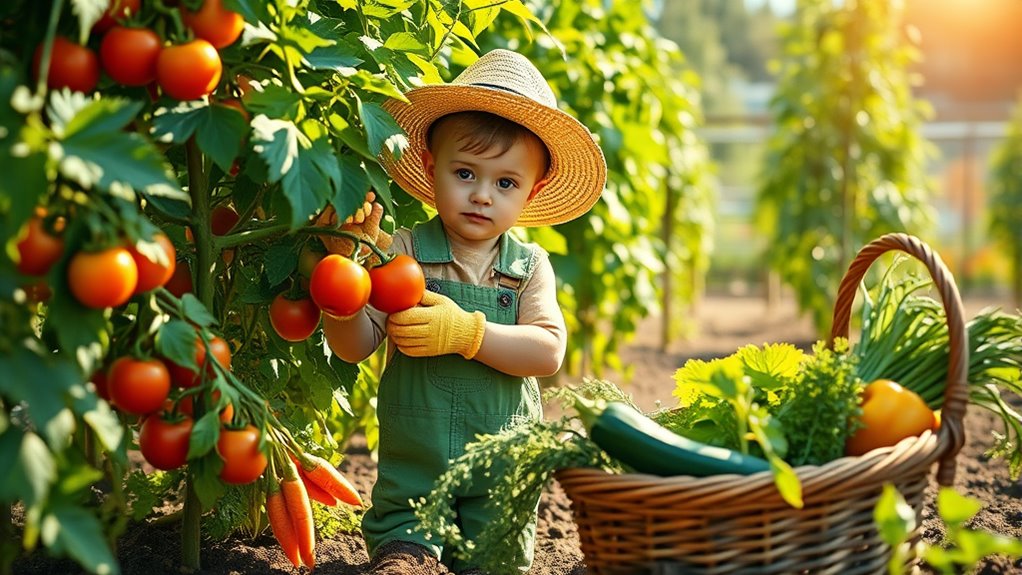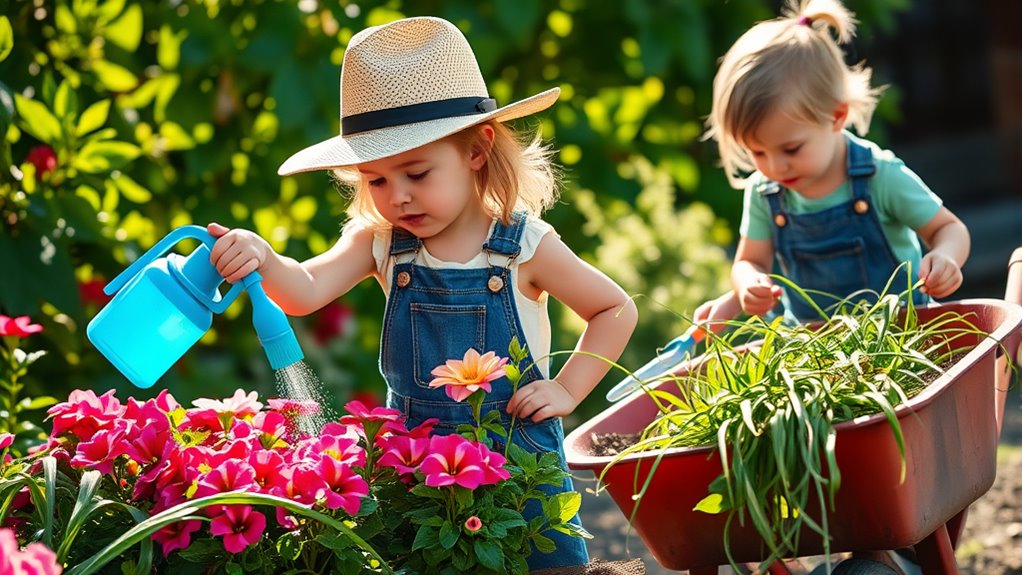To build responsibility in ages 6–10, involve them in gardening chores like planting seeds, watering, weeding, harvesting, and composting. These tasks teach kids to follow routines, care for plants, and understand the importance of responsibility. They’ll learn patience, teamwork, and how to handle tools and produce carefully. Keep them engaged with consistent garden duties, and they’ll develop lasting skills that grow well beyond the garden — discover how to turn gardening into valuable life lessons.
Key Takeaways
- Assign daily watering routines to teach consistency and responsibility.
- Involve kids in weeding and pest control to develop carefulness and problem-solving skills.
- Encourage harvesting and cleaning produce to promote organization and gentle handling.
- Include composting tasks to foster environmental awareness and sustainability habits.
- Promote participation in all garden chores to build a sense of achievement and accountability.
Planting and Watering Seeds

Have you ever wondered how tiny seeds grow into vibrant plants? When planting seeds, you play a vital role in their growth through proper seedling care. Start by choosing the right spot and digging small holes, then gently place the seeds in the soil. After planting, establish a consistent watering routine, ensuring the soil stays moist but not waterlogged. Kids can help monitor moisture levels and remember to water regularly, which teaches responsibility. Using a watering can makes the task fun and manageable. Remember, consistency is key—watering routines should happen at the same times each day. By taking care of seedlings early on, you’ll help them develop strong roots, setting the stage for healthy, thriving plants later in the garden. Proper watering techniques are essential to prevent issues like overwatering or underwatering, which can harm young plants.
Weeding and Maintaining Garden Beds

Keeping garden beds tidy is essential for healthy plants, and that means regularly weeding to remove unwanted plants that compete for nutrients and water. When you weed, you help improve soil preparation by loosening the soil and removing pests hiding among weeds. Use your hands or a small tool to carefully pull out weeds, making sure to remove roots completely. Maintaining your garden beds also involves checking for pests and applying simple pest control methods to protect your plants. Here’s a quick guide:
| Task | Benefits | Tips |
|---|---|---|
| Weeding | Reduces competition for nutrients | Pull weeds after watering |
| Soil preparation | Promotes healthy root growth | Loosen soil gently |
| Pest control | Keeps plants safe from harm | Use natural repellents |
| Pruning | Encourages new growth | Trim dead leaves |
| Mulching | Retains moisture | Apply around plants |
Regular maintenance of your garden beds supports overall plant health and ensures a thriving garden throughout the season.
Harvesting Fruits and Vegetables

Once you’ve tidied up your garden beds and removed weeds, it’s time to harvest the fruits and vegetables you’ve been growing. Use appropriate garden tools like scissors or pruning shears to gently pick ripe produce, avoiding damage to plants. Check for signs of ripeness, such as color and firmness, to ensure you’re harvesting at the right time. While harvesting, be mindful of pest control; inspect plants for insects or damage and remove any pests you find. This helps keep your garden healthy and prevents infestation. Teach kids to handle produce carefully and to clean it after harvesting. Properly storage methods after harvesting can help maintain freshness and prevent spoilage. Taking responsibility for harvesting not only gives them a sense of achievement but also helps develop their understanding of plant growth and garden maintenance.
Composting and Recycling Garden Waste

Did you know that turning garden waste into compost is a great way to help your plants grow and reduce trash? Composting promotes garden sustainability by recycling organic material back into the soil, enriching it naturally. When you compost leaves, vegetable scraps, and grass clippings, you’re practicing waste reduction, cutting down on landfill waste. It’s a simple chore that teaches responsibility and environmental awareness. Kids can help collect garden waste and learn how composting speeds up decomposition. Over time, this compost becomes a valuable soil amendment, supporting healthy plants. Recycling garden waste not only benefits your garden but also fosters a sense of stewardship. By making compost a regular part of your chores, you’re actively contributing to a greener, more sustainable garden. Celebrity lifestyle insights can inspire you to incorporate eco-friendly habits into your daily routine.
Frequently Asked Questions
How Can Gardening Teach Children About Patience?
You can teach children about patience by encouraging them to plant patience and cultivate perseverance through gardening. As they wait for seeds to sprout and plants to grow, they learn that good things take time. By nurturing their garden and seeing the results of their effort, children develop resilience and understanding that persistence leads to success. Gardening becomes a hands-on way to instill valuable lessons about patience and perseverance.
What Safety Precautions Should Kids Take While Gardening?
You might think gardening is just fun, but safety’s key. Always wear garden gloves to protect your hands from dirt and sharp objects. Remember sun safety—apply sunscreen, wear a hat, and seek shade when needed. These precautions help prevent injuries and sunburns, making gardening a safe, enjoyable activity. Taking responsibility for your safety also teaches you valuable lessons about caring for yourself while nurturing the garden.
How Does Gardening Help Develop Time Management Skills?
Gardening helps you develop time management skills by requiring you to follow consistent watering routines and stick to a planting schedule. You learn to prioritize tasks, plan ahead, and allocate time effectively to care for your plants. This regular routine teaches you discipline and organization, making it easier to manage other responsibilities. By staying on top of your gardening tasks, you build habits that improve your overall time management skills.
What Tools Are Safe and Suitable for Young Gardeners?
Imagine it’s the 19th century, and you’re guiding a young gardener. You should choose child appropriate tools that are lightweight, with blunt edges, and easy to handle. Gardening safety is a top priority, so make certain tools like small shovels, child-sized watering cans, and gardening gloves are used. These tools help kids learn responsibility while keeping them safe and engaged in gardening activities.
How Can Gardening Activities Be Adapted for Different Age Groups?
You can adapt gardening activities for different age groups by tailoring planting techniques to fit skill levels. For young children, simplify garden design with colorful, accessible beds and focus on basic tasks like watering and planting seeds. Older kids can handle more complex projects, such as composting or designing their own garden layouts. By adjusting activities this way, everyone stays engaged, learns, and develops responsibility through hands-on gardening experiences.
Conclusion
By helping out with garden chores, you’re planting the seeds of responsibility that will grow with you. Whether you’re watering plants, weeding beds, or composting, each task teaches you important life skills. Remember, patience and consistency pay off—your efforts will bear fruit in more ways than one. Keep at it, and you’ll see how taking care of the garden helps you grow into a responsible and confident individual.









